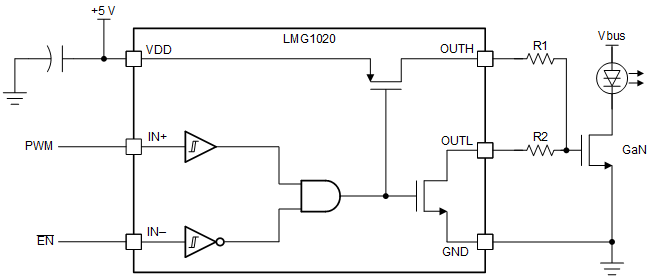SNOSD45B February 2018 – October 2018 LMG1020
PRODUCTION DATA.
- 1 Features
- 2 Applications
- 3 Description
- 4 Revision History
- 5 Pin Configuration and Functions
- 6 Specifications
- 7 Detailed Description
- 8 Application and Implementation
- 9 Power Supply Recommendations
- 10Layout
- 11Device and Documentation Support
- 12Mechanical, Packaging, and Orderable Information
Package Options
Mechanical Data (Package|Pins)
- YFF|6
Thermal pad, mechanical data (Package|Pins)
Orderable Information
8.2 Typical Application
The LMG1020 is designed to be used with a single low-side, ground-referenced GaN or logic-level Si FET, as shown in Figure 6. Independent gate drive resistors, R1 and R2, are used to independently control the turnon and turnoff drive strengths, respectively. For fast and strong turnoff, R2 can be shorted and OUTL directly connected to the transistor’s gate. For symmetric drive strengths, it is acceptable to short OUTH and OUTL and use a single gate-drive resistor.
TI recommends using at least a 2 Ω resistor at each OUTH and OUTL to avoid voltage overstress due to inductive ringing. Ringing overshoot must not exceed the maximum absolute supply voltage.
For applications requiring smaller resistance values, contact TI E2E for guidance.
 Figure 6. Typical Implementation of a Circuit
Figure 6. Typical Implementation of a Circuit